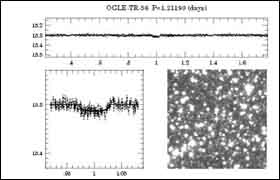A team of scientists in Israel and Hungary developed a new method for analyzing data from sky observations - which led to the identification of 13 more systems of distant planets
Dr. Noah Brosh

A star-studded field centered on the target star OGLE-TR-56 The measurements identified a stellar eclipse caused by the small body from the planet Saturn
Thanks to the data-analysis method developed by Prof. Zvi Maza and Shay Zucker from Tel-Aviv University, in collaboration with Dr. Geza Kovacs from Hungary, 13 new systems of planets have been identified, close to the Suns.
The method is based on measuring the intensity of light from a target star - which we observed - and detecting "eclipses" (a kind of eclipse). When the eclipses had a unique shape ("flat bottom"), this is the proof that it is a planet orbiting the target star in the same plane as the line of sight from Earth. This method is "sensitive" and more accurate than the others.
The research, which lasted about three years, examined the change of light from many stars, simultaneously. The observation area - in the center of the Milky Way, where the density of stars per unit of sky area is high - was photographed with high frequency, with electronic cameras. The images were compared and the star where a change, even a slight one, in the intensity of the light was detected was transferred to close monitoring. The light changes were studied and when an eclipse signature was seen, by another celestial body - the assumption is that it is a system where a planet orbits its own sun and causes a periodic eclipse.
The problem in analyzing such events is the tiny size of the planet (relative to its sun). In our solar system, the Earth's diameter is about 1% of the Sun's diameter. An observation to measure the brightness of the sun would have revealed that during a solar eclipse, the intensity of the light decreased by 0.01% compared to the normal situation (when there is no "eclipse"). This decrease in the intensity of the light is even more insignificant than it can be measured, when it comes to the other stars. "Eclipses" can only be measured when the giant planets, such as Jupiter and Saturn, are involved.
The new method for analyzing light changes focuses on detecting the signature of the planets that caused the eclipse. The intensity of the light then decreases slightly and suddenly; Remains constant for a while, and then returns to its original level.
The analysis developed by Kovets, Mazza and Zucker is sensitive to the conventional methods, based on the measurement of the gradual change in the intensity of light, when two bodies of similar sizes pass each other.
The new method was tested on data from photographs of five million stars. In the old method, 46 stars were discovered that change the intensity of their light as a result of "defects". In Hacha - 13 more systems (in addition to 46). Therefore, the new method will make it possible to significantly increase the rate of discovery of new planetary systems orbiting other suns in the universe.
https://www.hayadan.org.il/BuildaGate4/general2/data_card.php?Cat=~~~346217122~~~54&SiteName=hayadan
